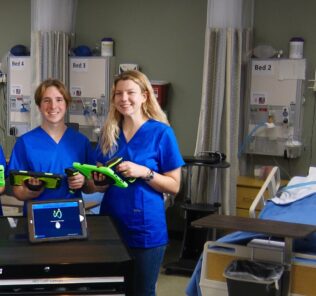Clinical Simulation Escape Rooms: Puzzle & Clue Ideas
As the 2021 International Meeting on Simulation in Healthcare (IMSH) virtual conference continues, a recent presentation explored escape room ideas for puzzles and clues as they relate to clinical simulation. The presentation was given by Traci Ashworth, MSN, BSN, RN, and Simulation Nurse Educator; and Kateri Gabriele, BSN, MS, Healthcare Simulation Consultant; both of the VA Northeast Ohio Healthcare System. Titled “Escape Room Toolkit: Build Adaptable Resources Through Innovation,” the discussion centered around the benefits of using escape rooms to meet healthcare simulation learning objectives.
According to the presentation, last year, while waiting at the San Antonio Airport for a flight home from the IMSH 2019 conference in San Antonio, Ashworth and Gabriele joined with others to create an escape room, which they titled “Remember The Alamo!” The nonclinical escape room focused on teamwork and collaboration. Participants had 30 minutes to work together to solve puzzles and clues to find their way out of a locked room in the Alamo Museum, which had closed with the participants locked inside. The escape room was offered to multiple participants at a Virginia staff training day. According to evaluations received after the event, the escape room fostered teamwork and was one of the most popular activities of the day.
The authors report that escape rooms can be inexpensive, portable and engaging; and bring different teams together and help to identify practice gaps. They may be linear, in which puzzles must be solved in sequence, or nonlinear, where the sequence of solving puzzles and opening locks does not have to be in a specific order except for the last one, which opens the door out of the escape room. One key feature the authors found most helpful was to make a simple map/drawing of the various activities.
Sponsored Content:
A map with a key is useful when multiple educators will use the same sequences in the escape room, and is a very helpful tool to aid in resetting the room quickly between groups. The authors noted that the scheduling of a repeatable escape room should include adequate time for resetting the room.
As with any other simulation, use current best practice in the design of the escape room simulations. Ashworth and Gabriele used the INACSL standards for simulation design. They started by identifying a need, and from there they listed the main goals for the escape room. Specific SMART learning objectives were identified.
Objectives related to teamwork and collaboration should be included, since the participants will have to work together to solve problems. Learning outcomes may be related to leadership roles, clinical content, or new policies or procedures. Start with the end goal in mind, and allow adequate time for debriefing to make sure all the learning objectives have been covered.
Next the authors identified the number of likely participants, their usual roles and their knowledge level. Space availability and room type were also identified. The number of learners for each run of the escape room was determined, as well as the suitability of the room size to accommodate the number of learners.
Sponsored Content:
The authors felt that more than five learners at one time was hard to manage. The total length of the activity required to meet the learning objectives, including time for prebriefing, escape room and debriefing was calculated. A budget was created which included the cost of equipment, consumables, paper supplies and locks, as well as the total number of times the escape room would be run and over what period of time, e.g. 48 sessions offered 4 times a week for 4 months.
Escape rooms often have themes. The authors recommend to try to make the escape room match the theme. For example, the authors created an escape room with the aim of helping participants recognize the signs and symptoms of chronic diseases. Ashworth and Gabriele started by creating a story about a group of pirates with chronic health diseases.
Each character had a health history and/or various signs or symptoms. During the escape room, assessments, labs or diagnostics can be identified and used to solve clues to move learners forward toward creating a diagnosis, priority treatment, or disposition of the patient (ED, home or “keep up the good work”). This type of escape room lends itself to IPE.
The authors recommend to always test the escape room with a dry run. If possible, include content experts and members of the target audience in testing to help identify any issues. Make sure the clinical content of the escape room is at an appropriate level, e.g. ICU-type clinical problems are not suitable for new grads.
Have ground rules about what the participants can and cannot do during the escape room, such as not looking under draped items in the room, or preventing access to cellphones. If simple locks are used to hold cardboard or material bags or boxes closed, the participants are not allowed to use excessive force to break items to get inside, but must instead solve clues to open locks. No climbing is allowed, and any electricity is real and should not be disturbed.
Use mannequins or speakers to offer clues if the learners get stuck. Have a large clock which learners can see. Consider giving warning bells to indicate time left in the escape room. If an alarm goes off, participants should treat it as a real alarm. Ideas for escape room puzzles and clues:
- Generate scannable QR codes which can provide clues for the next step in the escape room.
- Cut a simple sudoku puzzle into 3 strips. The puzzle cannot be solved until all pieces are located. Note: If none of the group members are familiar with sudoku puzzles, assistance or hints will be needed.
- Use a black light to hide critical information needed for solving a puzzle. Note that black light ink may be difficult to remove from some surfaces (e.g. whiteboards), so check before use.
- Decide whether participants can use cellphones to look up info.
- Provide hints; for example “Alex has a bar of soap in his suitcase” to direct learners to a sink.
- Show a series of pictures of clinical skills that must be done in a correct sequence, e.g. donning or doffing PPE.
- Participants must pick the 3 correct pictures out of 12 or so cards in the correct sequence. On the back, a code is revealed.
- Use different blood pressure cuffs (small, regular and extra large) with blood pressure clues attached. Only the appropriately-sized cuff will provide the correct blood pressure which solves a puzzle.
- Use a series of correct dosage calculations to solve a puzzle, or use correct medication selection with a code hidden on the bottom of the medicine.
- Make sure calculators are available.
- Have solving a puzzle lead to permission to use a smartphone.
- Laptop — solve a puzzle to open the laptop and then have another puzzle on the laptop, which can be based on knowledge of clinical content, or lab or diagnostic results.
- Distractors are sometimes used to demonstrate how teams can be delayed by spending too much time on insignificant issues. The authors used distractors sparingly, because the learners usually needed the entire time to solve puzzles and the distractors took too much time. For example, a Rubik’s cube delayed the escape room too much.
- Use maps where clues lead to countries/states with numbers associated with them. For example, one puzzle required knowledge of the flags that had flown over the state of Texas at various times in history. If the team guessed the wrong answer, they would not be able to solve the puzzle, since the numbers on the map would not open the next lock.
- Create activities where the team must split up in order to solve all the puzzles in time, and where leadership will be needed.
- Use riddles.
- Use laminated paper clues that can be reused.
- Create boxes, bags or containers out of old items, fabric, cardboard, canisters, gift bags, briefcases, cases, money boxes or even plastic food containers with holes made for locks.
- Locks: bicycle, money box, combination, keyed, canister, travel, zip ties
Escape rooms offer team-building and collaboration activities which are fun and engaging. They do not need to be expensive, but it may take time to create the clues and puzzles. I suspect the authors had as much enjoyment in creating the escape room as the learners did in participating. A win-win situation!
Learn more About Escape Rooms
Dr. Kim Baily, MSN, PhD, RN, CNE has had a passion for healthcare simulation since she pulled her first sim man out of the closet and into the light in 2002. She has been a full-time educator and director of nursing and was responsible for building and implementing two nursing simulation programs at El Camino College and Pasadena City College in Southern California. Dr. Baily is a member of both INACSL and SSH. She serves as a consultant for emerging clinical simulation programs and has previously chaired Southern California Simulation Collaborative, which supports healthcare professionals working in healthcare simulation in both hospitals and academic institutions throughout Southern California. Dr. Baily has taught a variety of nursing and medical simulation-related courses in a variety of forums, such as on-site simulation in healthcare debriefing workshops and online courses. Since retiring from full time teaching, she has written over 100 healthcare simulation educational articles for HealthySimulation.com while traveling around the country via her RV out of California.
Sponsored Content:


















